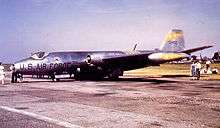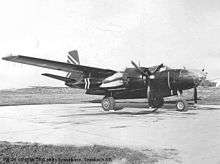30th Reconnaissance Squadron
| 30th Reconnaissance Squadron | |
|---|---|
|
Squadron Insignia | |
| Active | 1 September 2005 to current |
| Country |
|
| Branch |
|
| Role | UAV Reconnaissance |
| Part of | Air Combat Command |
| Garrison/HQ | Creech Air Force Base, Nevada |
| Engagements |
World War II Cold War |
| Decorations |
Order of the Day Citation, Belgian Army, September 1944, December 1944, 25 January 1945 |
| Commanders | |
| Notable commanders | Wing: John G. Lorber |
| Aircraft flown | |
| Reconnaissance |
P-38E/F-4 Lightning P-38G/F-5 Lightning F-6 (later RF-51D) Mustang RB-26B Invader B/RB-57A Canberra RB-66C Destroyer RF-4C Phantom II RQ-170 Sentinel |





The 30th Reconnaissance Squadron (30 RS) is reconnaissance test squadron[1] assigned to the 432d Air Expeditionary Wing (432 AEW) at Creech Air Force Base, Nevada. The 30 RS flies the RQ-170 Sentinel UAV out of the Tonopah Test Range Airport in Tonopah.
The squadron was previously assigned to the 57th Operations Group, 57th Wing, at Nellis Air Force Base, Nevada.[1][2][3][4]
Operations
Activated on 1 September 2005, at Tonopah Test Range Airport; and on 17 July 2007[2] it was assigned a new patch: the patch displays a black bird standing astride Asia and East Africa.[5]
In 2010 a detachment with RQ-170 Sentinels was sent to Al Dhafra Air Base in order to spy on the nuclear program of Iran.[6]
History
Established on 1 May 1943 as a Photographic Reconnaissance Squadron, initially trained under Second Air Force in Colorado; reassigned to Third Air Force in Oklahoma where the squadron received P-38E/F-4 Lightning reconnaissance aircraft.
Deployed to the European Theater of Operations (ETO) in England, being assigned to Ninth Air Force. Initially stationed at the Royal Air Force reconnaissance training school at RAF Chalgrove, later moved to RAF Middle Wallop where the squadron became operational in the ETO. The squadron arrived in Chalgrove in late February 1944 and began operations in March. Engaged in unarmed and extremely hazardous combat operations over Occupied Europe, mapping 6,000 square miles (16,000 km2) of the Netherlands and flew bomb-damage assessment missions over marshalling yards and gun emplacements in Belgium, the Netherlands, and France, in April 1944.
Earned DUC for participation with 10th Photographic Group, 7–20 May 1944, in photo reconnaissance of Utah beach for Normandy invasion. The citation read, in part: "Employing specially modified equipment installed in unarmed P-38 type aircraft, the intrepid pilots of the 10th Photographic Reconnaissance Group undertook the most hazardous missions. Flying unarmed and unescorted and at altitudes as low as twenty-five feet, they fearlessly piloted their aircraft over the difficult photographic runs in the face of intense fire from some of the strongest anti-aircraft installations in western Europe." Dicing, was the term used when referring to these extremely low-altitude flights over Utah Beach.
Flew sorties over France on D-Day making visual and photographic reconnaissance of bridges, artillery, road and rail junctions, traffic centers, airfields, and other targets. Moved into liberated area of France in early July, flying weather missions, made visual reconnaissance for ground forces, and photographed enemy positions to assist the First and Third Armies; Twelfth Army Group, and other Allied forces in the drive to Germany. Flew its first mission over Germany on 24 Aug 1944. Took part in the offensive against the Siegfried Line, Sep-Dec 1944, and in the Battle of the Bulge (Ardennes-Alsace), Dec 1944 – Jan 1945.
From then until the close of the war in Europe, the squadron photographed dams and bridges on the Roer River in preparation for the ground offensive to cross the river, and aided the Allied assault across the Rhine River and into Germany. Flew its 2,000th operational mission on 22 Mar 1945. Flew missions to Berlin on 8 April and to Dresden on 10 Apr 1945. Returned to the United States in July 1945, being assigned to Third Air Force, Continental Air Command at Drew Field, Florida. Squadron demobilized without becoming fully operational during the fall of 1945, inactivating on 7 November.
Re-established at Newark Army Air Base, New Jersey in 1947 as a Tenth Air Force Air Force Reserve corollary unit under the guidance of active duty units at McGuire AFB in order to train and maintain currency in reconnaissance operations for its reserve personnel. Primarily operated F-6 (later RF-51D Mustangs). Moved to McGuire AFB from Newark in 1949 when consolidated due to budget restrictions. Was brought to active service in 1951 due to manpower needs during the Korean War, personnel and aircraft being reassigned as fillers to various active-duty units. Inactivated as a paper unit in May 1951.
Reactivated under Tactical Air Command at Shaw AFB, South Carolina on 1 January 1953. Performed training of photo-reconnaissance pilots with RB-26B Invader aircraft. Deployed to NATO in July 1953, being assigned to the United States Air Forces in Europe at Sembach AB, West Germany; its host 66th Tactical Reconnaissance Wing being the initial unit based at the new air base. Trained in night reconnaissance with RB-26s; replaced with RB-57A Canberra jet aircraft in 1955. Was reassigned to the 10th Tactical Reconnaissance Wing at Spangdahlem AB in 1958 as part of a USAFE reorganization. Upgraded to RB-66C Destroyers and continued night reconnaissance training. Moved to England in 1959 when Spangdahlem became a Tactical Fighter base. Operated from RAF Alconbury, however rotated frequently to Toul-Rosieres AB, France where the 10th TRW operated a forward detachment until 1965.
Re-equipped with the RF-4C Phantom II reconnaissance aircraft in 1966; operated the day/night capable Phantom for 10 years until 1976 when inactivated due to budget reductions and the need for tactical reconnaissance aircraft was reduced to the increasing use of space reconnaissance assets.
Reactivated in 2005 and equipped with unmanned reconnaissance aircraft.
Lineage
- Constituted 30th Photographic Reconnaissance Squadron on 5 Feb 1943.
- Redesignated 30th Photographic Squadron (Light) on 6 Feb 1943.
- Activated on 1 May 1943.
- Redesignated 30th Photo Reconnaissance Squadron on 11 Aug 1943.
- Inactivated on 7 Nov 1945.
- Redesignated 30th Reconnaissance Squadron, Photo, on 11 Mar 1947.
- Activated in the Reserve on 25 Jul 1947.
- Redesignated 30th Strategic Reconnaissance Squadron, Electronics, on 27 Jun 1949.
- Ordered to Active Service on 1 May 1951.
- Inactivated on 16 May 1951.
- Redesignated 30th Tactical Reconnaissance Squadron, Night-Photo, on 15 Nov 1952.
- Activated on 1 Jan 1953.
- Redesignated: 30th Tactical Reconnaissance Squadron, Night Photo-Jet, on 8 Jan 1957.
- Redesignated: 30th Tactical Reconnaissance Squadron on 1 Oct 1966.
- Inactivated on 1 Apr 1976.
- Redesignated 30th Reconnaissance Squadron on 17 Jun 2005.
- Activated on 1 Sep 2005.
Assignments
- 7th Photographic (later, Photographic Reconnaissance and Mapping) Group, 1 May 1943
- Third Air Force, 21 Jun 1943
- III Reconnaissance Command, 12 Oct 1943
- Ninth Air Force, 4 Feb 1944
- 10th Photographic Group, 21 Feb 1944
- Attached to 67th Tactical Reconnaissance Group after 9 Jun 1944
- 67th Tactical Reconnaissance (later, Reconnaissance) Group, 13 Jun 1944 – 7 Nov 1945
- 66th Reconnaissance (later, Strategic Reconnaissance) Group, 25 Jul 1947 – 16 May 1951
- 66th Tactical Reconnaissance Group, 1 Jan 1953
- 66th Tactical Reconnaissance Wing, 8 Dec 1957
- Attached to 10th Tactical Reconnaissance Wing from 8 Jan 1958
- 10th Tactical Reconnaissance Wing, 8 Mar 1958 – 1 Apr 1976
- 57th Operations Group, 1 Sep 2005
- 432d Operations Group, 1 May 2007 – present
Stations
Aircraft
- P-38E/F-4 Lightning, 1943
- P-38G/F-5 Lightning, 1943–1945
- F-6 (later RF-51D) Mustang, 1947–1951
- RB-26B Invader, 1953–1955
- B/RB-57A Canberra, 1955–1957
- RB-66C Destroyer, 1957–1965
- RF-4C Phantom II, 1965–1976
- RQ-170 Sentinel, 2005–present
References
![]() This article incorporates public domain material from the Air Force Historical Research Agency website http://www.afhra.af.mil/.
This article incorporates public domain material from the Air Force Historical Research Agency website http://www.afhra.af.mil/.
- 1 2 Creech Air Force Base Official Site
- 1 2 Fulghum, David A. (2009). "U.S. Air Force Reveals Operational Stealth UAV". Ares. Aviation Week. Retrieved 4 December 2009.
- ↑ Hoffman, Michael, "Unveiling the ‘Beast of Kandahar’", Military Times, 23 December 2009.
- ↑ Nellis AFB: 432nd becomes Air Expeditionary Wing
- ↑ Tirpak, John A., Executive Editor (February 2010). "Washington Watch: Stealth Messenger". AIR FORCE MAGAZINE, Journal of the Air Force Association. Air Force Association. 93 (2): 6. ISSN 0730-6784. Archived from the original on 22 February 2010. Retrieved 2010-02-02.
- ↑ Axe, David; Trevithick, Joe (22 January 2014). "In 2010, the U.S. Surrounded Iran With Stealth Drones". medium.com. War is Boring. Retrieved 22 January 2014.
External links
![]() This article incorporates public domain material from the Air Force Historical Research Agency website http://www.afhra.af.mil/.
This article incorporates public domain material from the Air Force Historical Research Agency website http://www.afhra.af.mil/.
